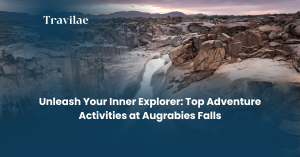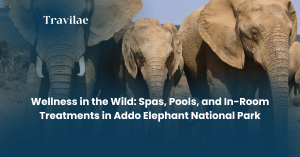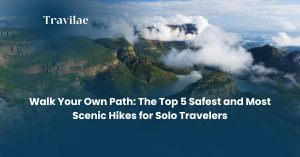When the Desert Wakes Up
As the fierce Kalahari sun dips below the granite horizon, a profound transformation begins at Augrabies Falls National Park. The daytime world of heat and rock gives way to a cooler, secret landscape ruled by shadow and sound. This is when the desert truly comes alive. A guided night drive here is more than just a tour; it’s a ticket to a hidden theatre of unique, nocturnal creatures. This guide will illuminate the magic of night drives at Augrabies Falls, revealing what you might see, how to plan your adventure, and why this is an unmissable experience for any wildlife lover.
Table of Contents
Why a Night Drive is a Must-Do Adventure
In an arid environment like Augrabies, the majority of animal activity happens under the cover of darkness. The cool night air allows animals to hunt, forage, and move without the stress of extreme heat. Opting for a guided night drive gives you a chance to see species that are virtually impossible to spot during the day.
The Nocturnal Stars of Augrabies
With a powerful spotlight and the keen eyes of your guide, you’ll search for the park’s elusive residents.

- Aardwolf: Neither an aardvark nor a wolf, this shy, striped creature is a unique hyena species that feeds almost exclusively on termites. Seeing one is a rare treat.
- Aardvark: The famous “earth pig” is a master digger with powerful claws. Spotting this solitary, ant-eating mammal is a bucket-list sighting for many safari enthusiasts.
- Bat-eared Fox: These charming small foxes use their enormous ears to listen for insects and larvae underground. They are often seen in pairs or small family groups.
- African Wild Cat: The wild ancestor of the domestic cat, these felines are slightly larger and leggier than their tame cousins. Spotting one hunting in the dark is a thrilling sight.
- Cape Fox: A small, delicate fox with a bushy black-tipped tail, often seen trotting through the scrubland.
- Leopard: The ultimate prize. While very elusive, leopards patrol the rocky gorges of Augrabies. A night drive offers the best, albeit slim, chance of a brief, heart-stopping encounter.
Planning Your Nocturnal Safari
Booking a Guided Night Drive
This is the best and safest way to experience the park after dark.
- How: You can book guided night drives directly at the park’s reception desk or through the official SANParks website before your trip.
- Why it’s better: The guides are experts at spotting nocturnal animals and can share fascinating insights into their behavior. They use high-powered spotlights responsibly and know the park’s roads intimately. You can relax and focus on the sightings.
Best Time for Wildlife Encounters

While night drives run year-round, the cooler, dry winter months (May to September) are often best. The vegetation is less dense, making animals easier to spot. Furthermore, the chilly nights encourage animals to be more active to generate warmth.
Tips for Night-Time Wildlife Photography
Photographing animals in the dark is challenging but rewarding.
- Use a high ISO: Don’t be afraid to push your camera’s ISO setting to 3200, 6400, or even higher to let in more light.
- Wide Aperture: Use a lens with a wide aperture (like f/2.8 or f/4) to maximize light capture.
- Fast Shutter Speed: You’ll still need a relatively fast shutter speed (e.g., 1/125s or faster) to freeze the animal’s movement.
- Don’t Use Flash: Your camera’s built-in flash is ineffective at a distance and will disturb the animals and ruin the atmosphere. Rely on the guide’s spotlight.
A Traveler’s Moment: The Shadow in the Spotlight

The air was crisp and cold as the open-sided vehicle trundled along the dusty track. For an hour, we’d seen only springhares hopping frantically away from the spotlight’s beam. Then, our guide suddenly killed the engine and swung the light towards a rocky outcrop. “Wait,” he whispered. We held our breath. At first, I saw nothing. Then, a shadow detached itself from the other shadows. It was low to the ground, its movements fluid and silent. A pair of intense, luminous eyes blinked in the beam. “Caracal,” the guide breathed. The sleek, reddish cat with its distinctive tufted ears paused for a heartbeat, staring right at us before melting back into the darkness. The encounter lasted no more than ten seconds, but the image of that wild, phantom cat is forever etched in my memory.
Sample 2-Day Wildlife Focus Itinerary
- Day 1: Sunset Views and Night Secrets
- Afternoon: Arrive and check in. Head to the main falls viewpoints for golden hour photography.
- Evening: Embark on your pre-booked guided night drive. Dress warmly!
- Night: Dinner at the park restaurant, buzzing with stories of what you saw.
- Day 2: Daytime Exploration and Departure
- Morning: Take a slow drive or mountain bike ride to the viewpoints like Ararat and Oranjekom. Daytime animals like giraffe, springbok, and klipspringer are active now.
- Midday: Enjoy a final lunch overlooking the gorge.
- Afternoon: Depart from the park, carrying memories from both its sunlit and moonlit worlds.
Night-Time Adventure FAQs
1. Is it safe to go on a night drive? Yes, guided night drives operated by SANParks are very safe. You are with a trained, armed guide in a specialized vehicle. You must remain in the vehicle at all times.
2. Can I do a self-drive at night in Augrabies? No, driving your own vehicle after the gates close is not permitted for safety reasons. The only way to explore the park at night is on an official guided drive.
3. What should I wear on a night drive? It gets surprisingly cold in the desert at night, even after a hot day. Dress in warm layers, including a fleece, a windproof jacket, a beanie (warm hat), and gloves. A blanket is also a great idea.
4. Will I be guaranteed to see a leopard or aardvark? No. Wildlife sightings are never guaranteed. The fun is in the search and the thrill of not knowing what’s around the next corner. Every drive is a unique adventure.
5. How long does a night drive last? Typically, guided night drives last between two and three hours.
Discover the Park’s Other Half
A visit to Augrabies isn’t complete until you’ve experienced its nocturnal side. The silence of the desert, the brilliant canopy of stars, and the thrill of spotting a creature of the night is an adventure that connects you to the wild heart of the Kalahari. It’s a powerful reminder that there is always more to discover if you just know when, and where, to look.
What nocturnal animal would you be most excited to see? Share your dream sighting in the comments!






